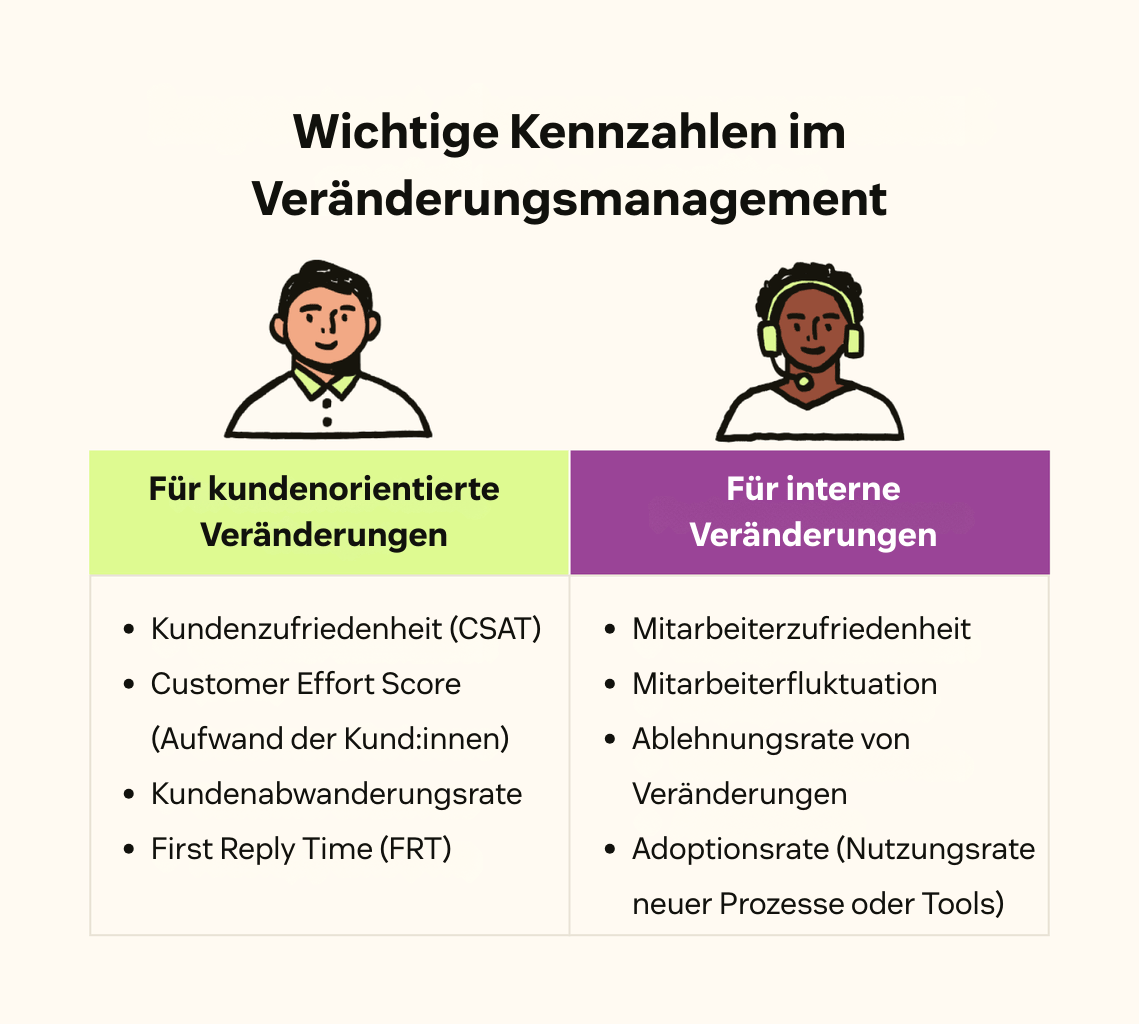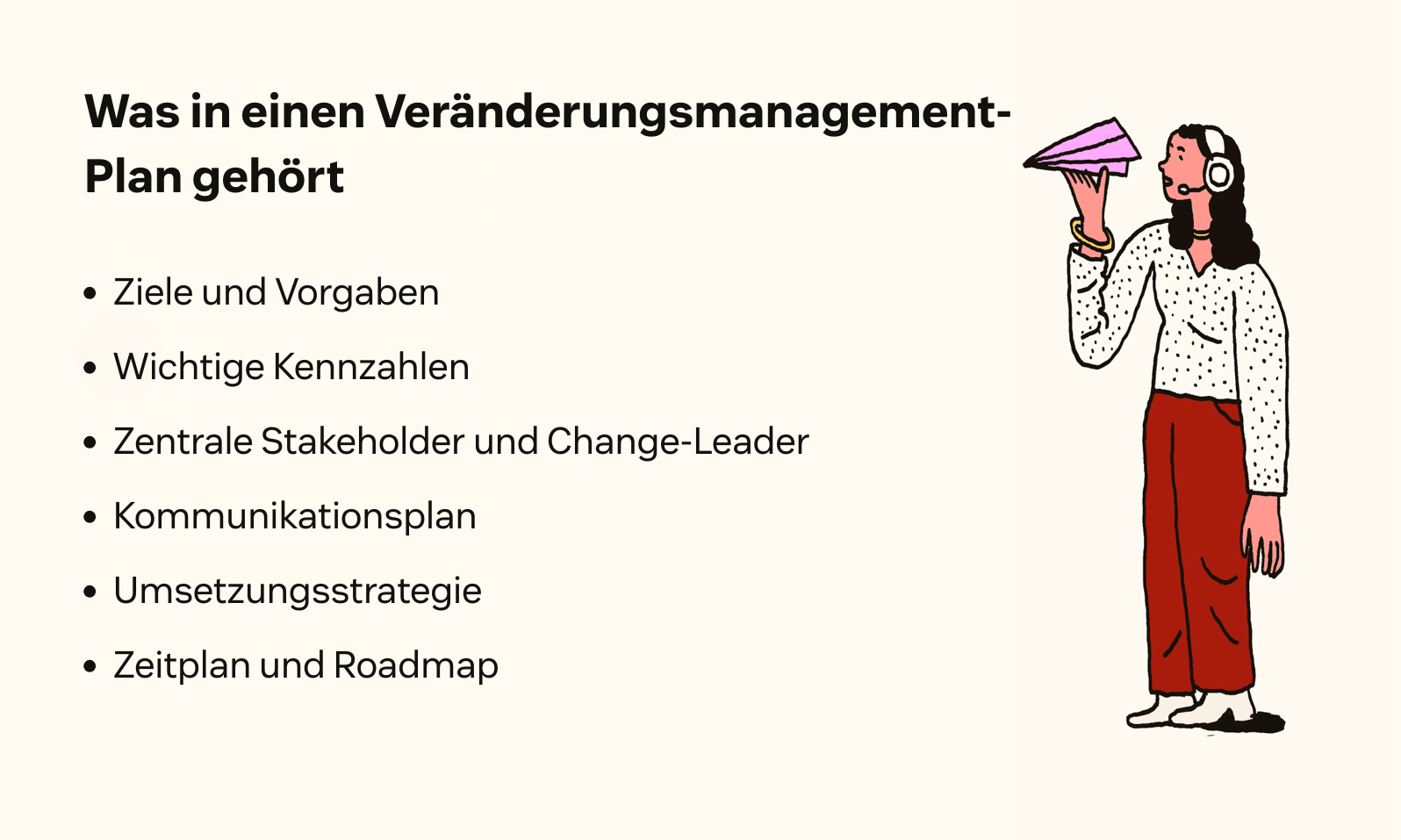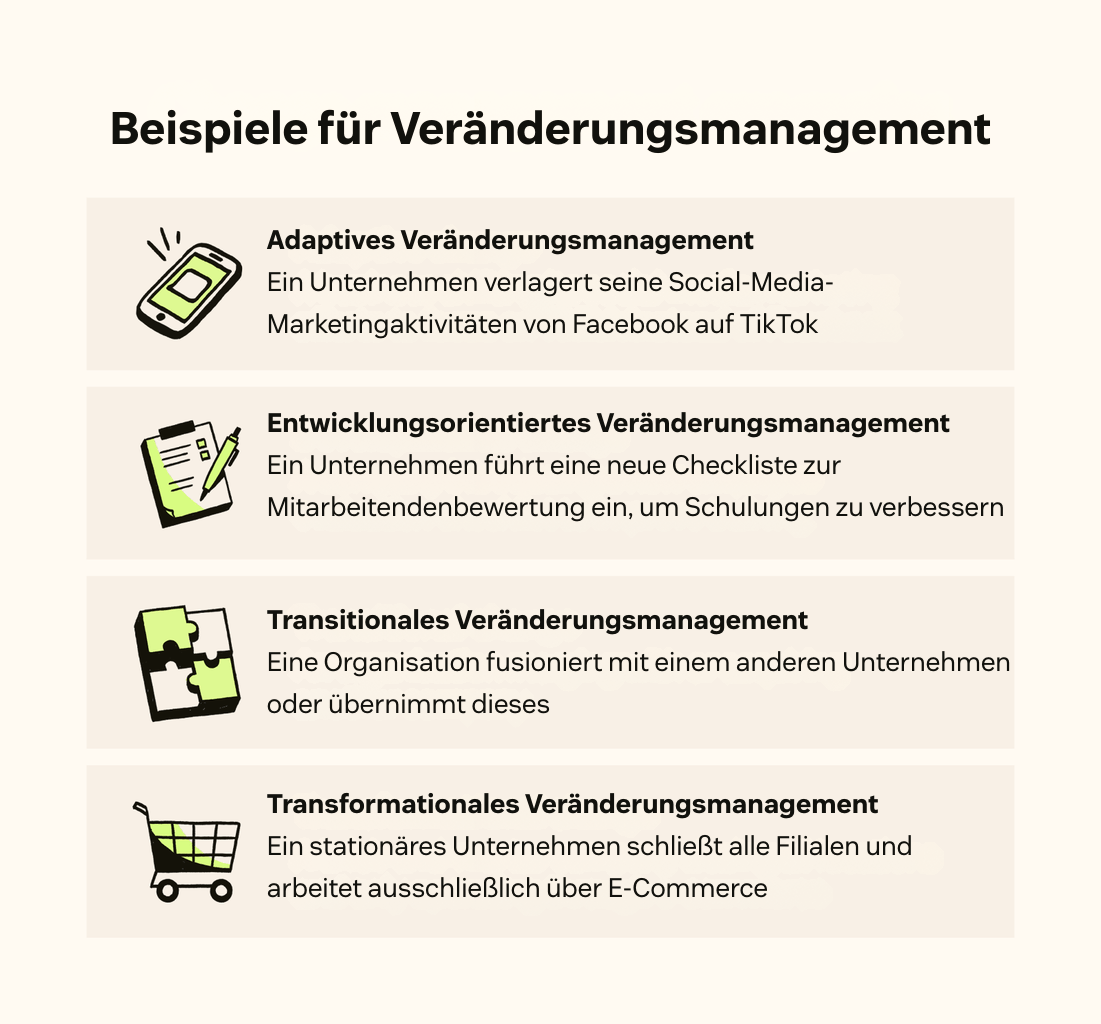Beitrag • 8 Min. Lesezeit
Was ist Veränderungsmanagement? Definition + 6 zentrale Schritte
Veränderungsmanagement hilft dabei, Menschen erfolgreich durch organisatorische Veränderungen zu führen. Erfahren Sie, was es beinhaltet, und entdecken Sie sechs Schritte, um es wirksam umzusetzen.
Zuletzt aktualisiert: 21. November 2025
Was ist Veränderungsmanagement?
Veränderungsmanagement (Change Management) umfasst Prozesse, Kommunikationsmethoden und Tools, mit denen Sie Veränderungen steuern und geschäftliche Ziele erreichen. Im Kern geht es darum, Menschen in Ihrer Organisation beim Anpassen an Veränderungen zu unterstützen – und sicherzustellen, dass diese Veränderungen nachhaltig verankert werden.
Jedes Unternehmen verändert sich. Mitarbeiter:innen kommen und gehen, Vorlieben von Konsument:innen verschieben sich, neue Technologien prägen Organisationen. Es reicht jedoch nicht, nur festzustellen, was geändert werden sollte. Laut Gartner sind nur 34 Prozent der Veränderungen von Dauer und klar erfolgreich. Das zeigt: Improvisation reicht nicht – Sie brauchen einen ganzheitlichen Plan.
In diesem Leitfaden finden Sie alles Wichtige zum Veränderungsmanagement. Von den zentralen Schritten bis zu grundlegenden Prinzipien des Change Managements lernen Sie, wie Sie in Phasen des Wandels flexibel und profitabel bleiben.
Mehr in diesem Leitfaden:
- Warum ist Veränderungsmanagement wichtig?
- 6 zentrale Schritte im Veränderungsmanagement-Prozess
- Arten des Veränderungsmanagements
- Vorteile des Veränderungsmanagements
- Häufig gestellte Fragen
- Im Veränderungsmanagement mit Zendesk exzellieren
Warum ist Veränderungsmanagement wichtig?
Veränderungsmanagement ist wichtig, weil es Ihrer Organisation hilft, strategische Anpassungen vorzunehmen, Störungen zu minimieren und Initiativen wirksam umzusetzen.
Unternehmen stehen häufig vor Situationen, die eine Kursänderung erfordern. Das reicht von inkrementellen Anpassungen – etwa einer Neuaufstellung der Support-Teamstruktur – bis zu groß angelegten Veränderungen wie der Einführung neuer Kundenservice-Software. Wirksames Veränderungsmanagement sorgt dafür, dass Veränderungen – ob klein oder groß – erfolgreich umgesetzt werden.
6 zentrale Schritte im Veränderungsmanagement-Prozess
Veränderungsmanagement bedeutet nicht nur, neue Wege zu beschreiten. Es geht darum, mit Mitarbeiter:innen, Stakeholdern und geschäftlichen Anforderungen im Einklang zu handeln, um bestmögliche Ergebnisse zu erzielen. Die folgenden zentralen Schritte des Change Managements helfen Ihnen, Ihre Ziele erfolgreich zu erreichen.
1. Veränderung definieren
Der erste Schritt für erfolgreiches Veränderungsmanagement besteht darin, die geplante Veränderung klar zu definieren. Beginnen Sie, indem Sie sich Fragen stellen wie:
Was genau soll in Ihrem Unternehmen verändert werden?
Wie sieht der aktuelle Zustand aus – und wie würde Erfolg aussehen?
Welche Personen sind von der Veränderung betroffen?
Wie groß ist das Ausmaß der geplanten Veränderung?
Wichtig ist vor allem zu verstehen, wie sich die neue Strategie kurzfristig und langfristig auf Ihre Geschäftsprozesse auswirken wird.
2. Kennzahlen bewerten

Sobald Sie Ihre Veränderungsziele definiert haben, sollten Sie die relevanten Daten analysieren. Ermitteln Sie Basiswerte für Ihre Leistungskennzahlen – beispielsweise Kundenservice-Kennzahlen, wenn die Veränderung den Kundenkontakt betrifft. So wissen Sie, wo Sie stehen und welche Ergebnisse Sie nach der Umsetzung anstreben. Diese Ausgangsdaten dienen später als Maßstab, um den Erfolg Ihrer Maßnahmen zu prüfen.
3. Change Agents auswählen
Selbst die beste Führung kann Veränderungen nicht allein umsetzen. Stellen Sie ein Team aus verschiedenen Bereichen Ihres Unternehmens zusammen – ein sogenanntes „Change Advisory Board“. Dieses Gremium liefert wertvolle Einblicke, wie Mitarbeiter:innen über die Veränderung denken, und kann potenzielle Hindernisse identifizieren. Führen Sie regelmäßige Meetings durch, um den Plan gemeinsam zu besprechen. Ermutigen Sie die Teilnehmenden, Updates an Kolleg:innen weiterzugeben, die Umsetzung zu begleiten und Schulungen zu koordinieren.
Wichtig: Dieses Team sollte Mitarbeiter:innen aller Ebenen umfassen, nicht nur Führungskräfte. Unterschiedliche Perspektiven stellen sicher, dass die Veränderungen sowohl die Produktivität als auch die Employee Experience verbessern.
4. Plan erstellen und umsetzen

Nach der Vorarbeit folgt die Entwicklung eines konkreten Veränderungsmanagement-Plans. Ihr Plan sollte alle oben genannten Punkte enthalten – zusätzlich eine Kommunikationsstrategie, einen Zeitplan und eine klare Vorgehensweise. Detaillierte Informationen helfen dem Umsetzungsteam, erfolgreich zu agieren. Legen Sie außerdem fest, wann und wie Sie die Veränderung kommunizieren. Halten Sie Ihr Team nicht im Unklaren.
5. Offene Kommunikation fördern
Ihr Veränderungsmanagement-Plan sollte eine kontinuierliche Feedbackschleife zwischen Mitarbeiter:innen und Stakeholdern enthalten. Diese kann Teammeetings, E-Mail-Updates oder formelle Mitteilungen umfassen. Fördern Sie offene Mitarbeiterkommunikation und ehrliches Feedback – und stellen Sie sicher, dass Sie zuverlässige Kanäle zur Datenerhebung nutzen. Anonyme Umfragen oder Einzelgespräche eignen sich hervorragend.
6. Ergebnisse analysieren und Erfolge feiern
Nach der Umsetzung gilt es, die Kennzahlen im Blick zu behalten. Anfangsschwankungen sind normal – wichtig ist, dass sich die Werte langfristig positiv entwickeln. Wenn Ihre Metriken keine Verbesserung zeigen, sollten Sie analysieren, wo der Prozess optimiert werden kann.
Unabhängig vom Ergebnis sollten Sie die harte Arbeit Ihres Teams würdigen. Dieser Schritt wird oft übergangen, ist jedoch entscheidend für die Motivation. Eine Anerkennung muss nicht aufwendig sein – ein gemeinsames Mittagessen, ein öffentliches Dankeschön oder kleine Geschenke reichen oft aus.
Entdecken Sie neue CX-Trends
Lesen Sie den Zendesk Customer Experience Trends Report mit KI-Unterstützung, um zu erfahren, wo Sie Veränderungen vorantreiben können.
Arten des Veränderungsmanagements

Nicht alle Veränderungen sind gleich. Manche sind kleine strukturelle Anpassungen, andere beeinflussen die gesamte Unternehmensstruktur. Deshalb tritt Veränderungsmanagement in mehreren Formen auf – hier die häufigsten:
- Adaptives Veränderungsmanagement: Kleine, schrittweise Anpassungen, die Unternehmen aufgrund äußerer Umstände vornehmen. Beispiel: Ein SaaS-Unternehmen veröffentlicht ein Software-Update.
- Entwicklungsorientiertes Veränderungsmanagement: Verbesserungen bestehender Prozesse oder Fähigkeiten. Das kann neue Verantwortlichkeiten oder Jobtitel umfassen oder ein unternehmensweites Projekt zur Verbesserung der Kundenservice-Kompetenzen.
- Transitionales Veränderungsmanagement: Der Wechsel von einem Zustand in einen anderen – also eine moderate Änderung der Arbeitsweise. Beispiel: Eine Organisation führt ein neues CRM oder eine neue Kerntechnologie ein.
- Transformationales Veränderungsmanagement: Eine tiefgreifende, groß angelegte Veränderung, die das Wesen eines Unternehmens neu definiert. Oft bedeutet das eine komplette Neuausrichtung – etwa, wenn ein Unternehmen ein völlig neues Produkt entwickelt und eine neue Mission verfolgt.
Die Art des Veränderungsmanagements hängt von Faktoren wie der Anzahl der beteiligten Mitarbeiter:innen und den sich verändernden Unternehmenswerten ab.
Vorteile des Veränderungsmanagements
Effektives Veränderungsmanagement bringt Ihrem Unternehmen zahlreiche Vorteile. Zu den wichtigsten zählen:
- Höhere Erfolgsquote bei Veränderungen: Unternehmen mit starken Veränderungsmanagement-Strategien erreichen ihre Ziele mit größerer Wahrscheinlichkeit und setzen Veränderungen erfolgreich um.
- Weniger Widerstand gegen Veränderungen: Es ist normal, dass manche Mitarbeiter:innen skeptisch reagieren. Mit gutem Veränderungsmanagement erreichen Sie mehr Akzeptanz im gesamten Team.
- Bessere Ressourcennutzung: Veränderungen können viel Zeit, Personal und Budget beanspruchen. Durch sorgfältige Planung und Koordination werden Ressourcen effizienter eingesetzt.
- Verbesserte Employee Experience: Selbst kleine Veränderungen beeinflussen, wie Mitarbeiter:innen arbeiten. Durch strukturiertes Veränderungsmanagement steigern Sie Zufriedenheit und schaffen ein positives Arbeitsumfeld.
Häufig gestellte Fragen
Im Veränderungsmanagement mit Zendesk exzellieren
Veränderung kann herausfordernd sein – muss es aber nicht. Mit einer klaren Vision, offener Kommunikation während des gesamten Prozesses und der Beobachtung Ihrer Kennzahlen schaffen Sie die Grundlage für nachhaltigen Erfolg. Gehen Sie noch einen Schritt weiter mit Zendesk. Unsere umfassenden KI-Funktionen – wie Zendesk QA – erkennen Verbesserungspotenziale und unterstützen die Kommunikation mit Mitarbeiter:innen und Kund:innen. So erhöhen Sie die Wahrscheinlichkeit, dass alle Beteiligten den Wandel annehmen und erfolgreich umsetzen.
